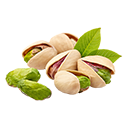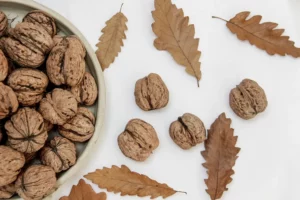Walnut
Walnut is a fruit of Jungians. This is a Latin abbreviation for Jives glens, meaning the dominant bead of a customer or the bead of “gods.” The fruit is not a true nut of a woody plant; it is a drupe with an edible seed (commonly called a nut) enclosed in a thick, hard shell.
Tracing the native home of the walnut tree is difficult, but ancient Romans believed it originated from Iran. The initial cultivation spanned from Southeastern Europe to Asia Minor to the Himalayas. Iran ranks third globally in annual walnut production, exceeding 200,000 tons.
Iranian walnuts are the second most important nut crop in Iran. It is estimated that there are over 20 million walnut trees in the country, mostly in the form of saplings. They are distributed along the borders of farms and gardens or spread across valleys.
The total walnut production, including the shell, is estimated at 400,000 tons.
Types of Walnuts:
The name of Iranian walnuts is derived from the regions where they are cultivated. For instance, we have walnuts from Tooyserkan, Shahmirzad, Qazvin, Taleqan, Shahr-e Kord, Damavand, and Azerbaijan. Other varieties include Kaghazi (Paper walnut), Sangei (Stone walnut), Makui (Makui walnut), Sazini (Needle walnut), Nok-e Kalaghi (Crow beak walnut), and Ziaabad (Ziaabad walnut). At Akam Trading, we offer 7 types of walnuts:
1. Kaghazi Walnut
2. Khoshe-e Walnut (Cluster Walnut)
3. Sazini Walnut
4. Damavand Walnut
5. Ziaabad Qazvin Walnut
6. Shahmirzad Walnut
7. Tooyserkan Walnut
Walnut kernel
Iranian walnut kernels are categorized into three types based on their size, fat content, color, and whether they are halved.
Nutritional Information:
The nutritional information below is provided by the USDA for one ounce (28 grams) or approximately seven whole English walnuts or 14 halves.
– **Calories:** 183cal
– **Fat:** 18g
– **Sodium:** 0.6mg
– **Carbohydrates:** 3.8g
– **Fiber:** 1.9g
– **Sugar:** 0.7g
– **Protein:** 4.3g
**Carbohydrates:**
One serving of walnuts contains only about 3.8 grams of carbohydrates. A minimal amount of it is starch (0.017g), and there’s a small amount of natural sugar (0.7g). Most of the carbohydrates in walnuts come from healthy fiber (1.9g). Walnuts have an estimated glycemic index of 15, classifying them as a low-glycemic food. The estimated glycemic load for one serving of walnuts is 1. Glycemic load considers the portion size when predicting the impact of a food on blood sugar.
**Fats:**
Most of the calories in walnuts come from fat. Consuming one serving of nuts provides 18 grams of fat. The majority of this fat comes from polyunsaturated fats (13.4g), with a small amount of monounsaturated fat (2.5g) and a very small amount of saturated fat (1.7g). Polyunsaturated and monounsaturated fats are considered healthy fats, typically coming from plant sources like nuts, seeds, and avocados. Research consistently shows that replacing saturated fats with polyunsaturated or monounsaturated fats helps reduce the risk of cardiovascular diseases.
**Protein:**
In addition to providing fiber and healthy fats, walnuts also offer a source of healthy protein. One serving provides over 4 grams of protein.
**Vitamins and Minerals:**
An ounce of walnuts covers 37% of the recommended daily intake of Vitamin E, 8% of the recommended daily intake of calcium, and 6% of the recommended daily intake of iron. Walnuts are an excellent source of manganese and copper, providing half of your daily needs. They are also good sources of magnesium and phosphorus. Nuts also provide lower amounts of iron, calcium, zinc, potassium, and selenium. The vitamins present in walnuts include Vitamin B6, folate, and thiamin.
Consuming walnuts as part of a nutritious diet can have various health benefits.
**Improves Heart Health:**
Studies suggest that walnut consumption reduces the risk of cardiovascular diseases. A study showed that incorporating walnuts into a calorie-controlled diet improved LDL cholesterol levels and systolic blood pressure compared to a low-calorie diet alone. Other research indicates that tree nuts, including walnuts, are associated with reduced cardiovascular risk factors, lower waist circumference, higher HDL cholesterol, and a lower likelihood of obesity.
Health experts generally recommend walnuts as part of a heart-healthy diet, emphasizing the benefits of polyunsaturated fats for heart health.
**Aids in Healthy Weight Management:**
The overall consumption of nuts has been linked to better weight management and fat reduction. Some studies, partially funded by the California Walnut Commission, even suggest that walnuts specifically can assist in achieving and maintaining a healthy weight.
Independent studies also indicate that nut consumption is associated with body weight reduction and a lower risk of metabolic syndrome and obesity-related issues. However, authors of a research review suggest that more studies are needed to gain a deeper understanding and determine the specific health benefits of certain nuts.
Walnuts are a good source of protein and fiber, making them a smart choice for weight loss. Fiber and protein can help keep you feeling full, and foods rich in fiber can contribute to a steady glucose supply, preventing sharp increases in blood sugar. Studies have shown that consuming fiber-rich foods can assist overweight or obese individuals in maintaining a healthier weight.
**Enhances Brain Health:**
A published study in the Journal of Nutrition suggests that walnut consumption may have beneficial effects on maintaining brain health with age. The authors note that preventing many neurological diseases can potentially be achieved earlier with the consumption of a healthy diet rich in antioxidants and anti-inflammatory phytochemicals.
Walnuts contain the highest levels of phenols and flavonoids among common nuts and have the highest antioxidant content. The study concludes that consuming a walnut-rich diet, along with other antioxidant-rich foods, is one of the simplest ways to reduce the risk of cognitive decline associated with aging.
**Reduces Prostate Cancer Risk:**
A published study refers to research indicating that consuming 75 grams of walnuts per day improves prostate biomarkers and vascular status in men at risk of prostate cancer. The study authors highlight that the high tocopherol content of walnuts is likely a contributing factor to this benefit.
Another study demonstrated the potential reduction in the risk of prostate cancer when men consumed 35 grams of walnuts per day. While some other animal studies have explored the relationship between walnut consumption and prostate cancer, strong human evidence is lacking.
**Reduces Inflammation:**
Other studies suggest that the nutritional components in walnuts may combat inflammation and, consequently, the risk of certain cancers. However, the authors of this study also note that clinical evidence directly assessing the risk of walnut consumption and cancer is limited.
For maximum freshness, store your walnuts in a sealed container in the refrigerator or freezer, depending on when you plan to use them. Keeping walnuts cool can prevent them from spoiling. Walnuts stored in the refrigerator should be kept away from strongly aromatic foods such as onions, garlic, or fish, as walnuts can absorb the flavors of other foods.
If you intend to grind your walnuts for use as a walnut ingredient, wait until you are ready to use them in your recipe to preserve the best flavor.
10kg
25kg
50kg
Process
As you know the walnut tree is a precious plant with high economic value. Different parts of this tree including its root, leaves, fruits, branches, and trunk are used in different industries like the food industry, carpentry, pharmacology, and medicine.
Walnut trees can reach 25–35 meters high and can live up to 200 years. The trunk of walnut tree has a smooth, silver- grey bark. The leaves of this tree are also fragrant. The tree produces male flowers on catkins and female flowers on terminal clusters where the fruit develops. The fruit of the walnut tree is a fleshy green drupe which envelopes the nut. The kernel of the nut is protected by a corrugated woody shell. Walnut trees have long compound leaves with 5 to 23 short-stalked leaflets. The male and female reproductive organs are borne in different petal-less flower clusters, known as catkins, on the same tree. The twigs characteristically contain a many-chambered pith.
 Any delay in picking the fruit after becoming ripe can reduce its quality and expose the tree to pests.The Walnut tree is sensitive to extreme heat and cold in summer and winter. The period for the tree to reach the age of fecundity is directly related with the type of the tree and the weather of the region.
Any delay in picking the fruit after becoming ripe can reduce its quality and expose the tree to pests.The Walnut tree is sensitive to extreme heat and cold in summer and winter. The period for the tree to reach the age of fecundity is directly related with the type of the tree and the weather of the region.
Walnuts may be either English or the black walnut varieties, with the latter having a thicker shell and more intense flavor. Both types are fruiting, deciduous trees that are fairly easy to grow and lacking in few serious issues especially once mature. Depending upon the variety and region they are grown in, walnut tree harvesting starts from early September to early November. At this point, the kernels are light in color and the membrane between the halves has turned brown.

To determine if your nuts are ready for harvest, crack a few open. The nuts should show browning of the membrane and loosening of the hull. Take your nut samples from as high up in the tree as possible since those that are at this height ripen the latest. Also, if your tree is water stressed, harvesting walnuts will be delayed. To speed things up, be sure to keep the tree well watered through harvest. Begin harvesting when you estimate that at least 85% of the nuts can be easily removed from the tree. Additionally, if you delay too long, the outer husks become soft and black and the resulting nut has a bitter, rancid flavor. To begin harvesting walnuts, you will need a pole or a pole combined with a hook for larger trees. Shake the nuts loose using the pole. Immediately pick the walnuts up from the ground. If they lie there too long, they will either begin to mold or become overrun with ants or both.
The length of time until complete drying depends on temperature but, generally, will be dry in three to four days. At this point, the kernels should be brittle as well as the membrane separating the two halves. Store the cured walnuts in a cool, dry area or to extend their shelf life, in the refrigerator or freezer.

 Pistachio
Pistachio Almond
Almond Walnut
Walnut Barberry
Barberry Raisins
Raisins Saffron
Saffron Jujube
Jujube Dried Fig
Dried Fig Kaloote
Kaloote Piarom
Piarom Zahedi
Zahedi Mazafati
Mazafati Estameran
Estameran Rabbi
Rabbi


